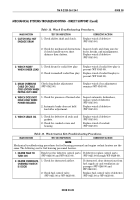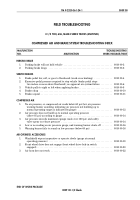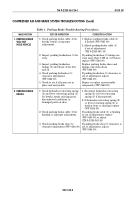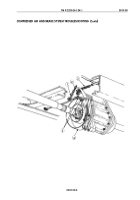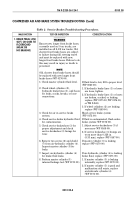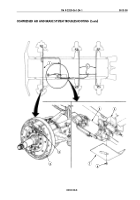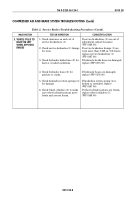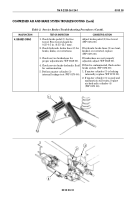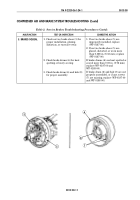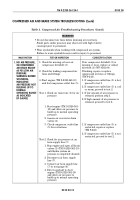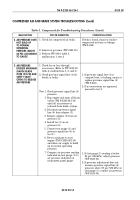TM-9-2320-361-24-1 - Page 166 of 1176
TM 9-2320-361-24-1
0010 00
0010 00-6
COMPRESSED AIR AND BRAKE SYSTEM TROUBLESHOOTING (Contd)
Table 2. Service Brakes Troubleshooting Procedures (Contd).
MALFUNCTION
TEST OR INSPECTION
CORRECTIVE ACTION
2. EXCESSIVE PEDAL
PRESSURE REQUIRED
TO STOP VEHICLE
(BRAKE PEDAL
STOPS TWO INCHES
OR MORE ABOVE
FLOORBOARD); NO
APPARENT AIR
SYSTEM FAILURE
1. Check service brakeshoe (1) linings
for oil or grease contamination.
2. Direct assistant to apply service
brakes and listen for evidence of
air escaping at air hydraulic
cylinder (2) and at vent (5).
Test 1. Check air-hydraulic cylinder
(2) for proper delivery line (7)
supply pressure.
1. Stop engine and open all drain
valves (TM 9-2320-361-10)
until brake system air
pressure is completely drained.
2. Remove two screws (3) and
shield (4) from air-hydraulic
cylinder (2).
3. Disconnect delivery line (7)
from elbow (6).
4. Remove elbow (6) from air-
hydraulic cylinder (2).
5. Install tee (9) on air-hydraulic
cylinder (2).
6. Connect test gauge (8) and
delivery line (7) to tee (9).
7. Direct assistant to start
engine (TM 9-2320-361-10)
and allow air pressure to build
to normal operating pressure.
NOTE
Air pressure gauge in instrument
panel has a maximum pressure
reading of 120 psi. If old governor has
been replaced with new governor, air
pressure may exceed maximum
pressure reading on instrument panel
gauge.
8. Check test gauge (8) reading
and compare with reading on
instrument panel air pressure
gauge.
If service brakeshoe (1) linings are
saturated with oil or grease, repair oil
or grease leak and replace brakeshoes
(WP 0167 00).
1. If escaping air is present, replace
air-hydraulic cylinder
(WP 0171 00).
2. If no air is escaping, proceed to
test 1.
1. If reading on test gauge (8) is same
as instrument panel air pressure
gauge, replace air hydraulic
cylinder (2) (WP 0171 00).
2. If reading on test gauge (8) is less
than instrument panel air pressure
gauge, check delivery line (7) for
restrictions. If delivery line (7) is
damaged or restricted, replace
(TM 9-243).
Back to Top

